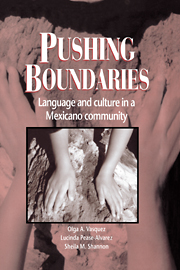Book contents
- Frontmatter
- Contents
- Foreword
- Preface
- Chapter 1 INTRODUCTION
- Chapter 2 EASTSIDE: A MEXICANO COMMUNITY
- Chapter 3 HOME AND SCHOOL CONTEXTS FOR LANGUAGE LEARNING
- Chapter 4 BILINGUAL CHILDREN CROSSING CULTURAL BORDERS
- Chapter 5 NEGOTIATING CULTURE AND LANGUAGE IN THE HOME
- Chapter 6 MOVING TOWARD A RECOGNITION PERSPECTIVE
- Chapter 7 MEETING THE CHALLENGES OF DIVERSITY
- Notes
- References
- Index
Chapter 1 - INTRODUCTION
Published online by Cambridge University Press: 26 March 2010
- Frontmatter
- Contents
- Foreword
- Preface
- Chapter 1 INTRODUCTION
- Chapter 2 EASTSIDE: A MEXICANO COMMUNITY
- Chapter 3 HOME AND SCHOOL CONTEXTS FOR LANGUAGE LEARNING
- Chapter 4 BILINGUAL CHILDREN CROSSING CULTURAL BORDERS
- Chapter 5 NEGOTIATING CULTURE AND LANGUAGE IN THE HOME
- Chapter 6 MOVING TOWARD A RECOGNITION PERSPECTIVE
- Chapter 7 MEETING THE CHALLENGES OF DIVERSITY
- Notes
- References
- Index
Summary
Everyday uses of language influence what we do, think, and learn. The conversations that we have on issues that concern us contribute to the formation of our opinions and theories. The talk that accompanies the solution of a problem or the completion of an unfamiliar task contributes to learning how to approach similar problems and tasks. The talk that involves our children contributes to their learning of language and ways of the society into which they are born. Thus, the language we use is a tool that mediates our thinking and learning. Moreover, it is an important window into the social and intellectual worlds of its users.
In this book we capitalize on this revelatory function of language to provide a window into the intellectual and social, or, to be more specific, cultural resources of individuals who are members of a Mexican immigrant community we call Eastside. Our descriptions of the language that involves children in this community yields a positive and dynamic portrayal of their socialization experiences. Through our careful examinations of their talk, we have learned that adults and children who live in this community deliberately seek out and draw upon a range of linguistic and cultural resources to meet the challenges of a complex, unfamiliar and, sometimes, oppressive society.
At the heart of our work lies a concern with the interrelationships that exist between language, culture, learning, and knowledge. Because these domains interact, information about one also yields important insights about another.
- Type
- Chapter
- Information
- Pushing BoundariesLanguage and Culture in a Mexicano Community, pp. 1 - 18Publisher: Cambridge University PressPrint publication year: 1994



